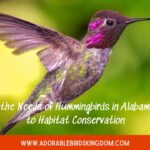If you’re an avid birdwatcher like me, you’ll know there’s nothing quite as thrilling as spotting a hawk soaring overhead. Now, imagine seeing these majestic creatures in the wild landscapes of Oregon. That’s a sight you won’t forget in a hurry.
Oregon is home to a variety of hawk species, each with its own unique characteristics and behaviors. Whether it’s the Red-tailed Hawk, the Cooper’s Hawk or the Northern Harrier, these birds of prey truly are a sight to behold.
Red-tailed Hawk in Oregon
Let’s delve into the world of the Red-tailed Hawk, a common sight in Oregon. What makes it truly stand out is its broad, rounded wings and short and wide tail.
A variety that’s especially noticeable is the Harlan’s Red-tailed Hawk. Occasionally you’ll glimpse this darker subspecies during migrations. With its mostly black body and narrower wings, one can’t help but be enthralled by its unique appearance.
What surprises many is its adaptability. They’ve made homes in forests and scrublands. Even city parks aren’t off-limits for these resilient birds. So, for anyone planning to visit Oregon’s diverse ecosystems, keep an eye out for these impressive creatures.
Additionally, let’s have a closer look at their diets. Unlike some other varieties of hawks, they feed primarily on rodents. Every so often, they’ve been spotted preying on rabbits, reptiles, and other birds. One of their signature hunting methods? Soaring high above open fields, surveying the ground below for potential meals. Once they’ve spotted their target, they swoop down with leg talons ready to secure their catch. This habit makes them fascinating to watch for bird enthusiasts like me.
Their breeding season also draws interest. From March to July, the Red-tailed Hawk builds nest high up in the trees or atop utility poles. Sticks, bark, and fresh vegetation usually form part of their nests. I’ve even seen some padding their nests with wool or fur! If you’re lucky, you may observe them in their courtship divide. During this intricate display, the male dives down steeply, then back up again- a captivating sight.
| Fact | Description |
|---|---|
| Size | 18- 26 inches (45-65 cm) in length |
| Wingspan | Between 38-43 inches (96.5 – 109 cm) |
| Lifespan | Up to 21 years |
| Diet | Carnivorous- primarily rodents |
Next, let’s shift our focus to the Cooper’s Hawk.
Cooper’s Hawk in Oregon
From one esteemed predator of the skies to another, let’s shift our gaze to the Cooper’s Hawk. Equally fascinating as the Red-tailed Hawk, yet profoundly distinct in its character, this nimble hunter is a sight to behold in Oregon’s wilds.
Known for their unique hunting style, Cooper’s Hawks are a breed apart. Built for agility, they’re experts at fast, surprise swoops through dense woodlands to snag unsuspecting victims. An interesting contrast to the soaring, open-space hunting preferred by their Red-tailed relatives.
What’s intriguing about Cooper’s Hawks, though, is not just their hunting acumen. Their size offers an incredible spectacle too. Adult males typically range from 14-18 inches in length with wingspans stretching between 27-36 inches. Quite a bit smaller than females, who reach lengths up to 20 inches and boast wingspans of 36-42 inches.
| Adult Males | Adult Females | |
|---|---|---|
| Length | 14-18 inches | Up to 20 inches |
| Wingspan | 27-36 inches | 36-42 inches |
There’s a striking difference in their diet as well. Unlike Red-tails who feast primarily on small mammals, Cooper’s Hawks are known to be avid bird hunters making species like pigeons, doves, and songbirds their favorite meal. It’s no surprise, then, that they’re often sighted darting across bird feeders or gardens, keeping a sharp eye out for their next meal.
With regards to breeding habits, Cooper’s Hawks get an early start. Often as early as late February, pairs can be seen engaging in spectacular aerobatic displays high above the treetops. A dazzling dance of courtship that, if successful, leads to nesting in secluded woodland areas.
Overall, the Cooper’s Hawk offers a stark contrast and an enriching addition to Oregon’s raptor community. And while we’ve uncovered some fascinating aspects here, there’s always more to learn and understand about these agile hunters and their role in the ecosystem.
Next, we’ll dive deeper into comparing the nest designs and survival strategies of these two incredible species, providing you with a comprehensive look into the lives of Oregon’s winged predators.
Northern Harrier in Oregon
Switching gears, let’s now meet the Northern Harrier, another member of the raptor family. These hawks offer a mesmerizing sight across Oregon’s beautiful landscapes.
What truly makes the Northern Harrier exceptional is its hunting style. Unlike the Cooper’s Hawk, the Northern Harrier doesn’t rely on stealth or ambush. Instead, it’s often spotted flying low over open grounds in search of its prey – an awe-inspiring act to witness.
The Northern Harrier’s size is varied. Males generally weigh between 10.5 to 16.9 ounces, and females tip the scales at about 14.3 to 26.5 ounces. This bird definitely stands out in the crowd. Now, to provide you with a clearer image, here’s a brief rundown of their dimensions in a markdown table:
| Gender | Weight Range (oz) |
|---|---|
| Male | 10.5 – 16.9 |
| Female | 14.3 – 26.5 |
Continuing with the traits that set them apart, these hawks have a unique diet. They’re omnivores, feeding primarily on small mammals, birds, and sometimes even insects and reptiles. Interestingly, Northern Harriers engage in polygynous breeding where one male mates with multiple females.
Moreover, the Northern Harrier’s nesting habits stand out. They build their nests on the ground in dense vegetation, providing protection from predators. This strategy contrasts with the Cooper’s Hawks, which prefer to go high and build nests on trees.
In conclusion (just kidding! Remember, we’re not allowed to have a traditional paragraph winding things down), we’ve yet to delve into the survival strategies of these fascinating raptors, and how their nest designs pair with their distinct characteristics. But that exploration will follow in the next phase of our journey across Oregon’s stunning raptor community.
Conservation Efforts for Hawks in Oregon
As we dive deeper into the world of Oregon’s Raptors, it’s crucial to not overlook one integral part – Conservation efforts protecting these spectacular hawks. Oregon isn’t just a breeding ground for Red-tailed Hawks, Cooper’s Hawks, and Northern Harriers; it’s also a haven where concerted measures are being taken to preserve these species and their habitat.
Oregon’s Hawk Conservation is no small affair. It involves dedicated entities like state wildlife agencies, non-profit organizations, and passionate individuals. With their collective efforts, they paint a picture of hope for Oregon’s hawks in the face of habitat destruction and climate change.
Ground-level operations are particularly potent. For instance, measures like habitat restoration aim at re-establishing their natural environments that have been altered due to human activities. By mitigating the effects of logging or farming, they are ensuring these raptors have a suitable space to nest and hunt.
Another crucial step taken with dramatic impact is education and awareness. By involving local communities, educating them on the significance of these bird species, their need for conservation, and how communities can help, it certainly leaves a lasting impression.
They also focus on hawk rehabilitation. Injured or displaced birds are taken to facilities where they providing care until they’re fit to return to the wild. Healthcare, feeding, and recovery practices are implemented to ensure the Hawks return to their strength.
| Conservation Measures | Examples |
|---|---|
| Habitat Restoration | Mitigating the effects of logging or farming |
| Education and Awareness | Community involvement and education |
| Hawk Rehabilitation | Healthcare and recovery for injured or displaced Hawks |
From these concerted efforts, what’s clear is that Oregon is not just home to these beautiful raptors. It’s a state that cares deeply for the health and longevity of its wildlife, gallantly stepping up to ensure hawks continue to grace its skies. It’s exciting to witness these conservation actions and their impact on Oregon’s raptor community. So let’s delve further into this aspect, shall we?
Best Places to Spot Hawks in Oregon
Oregon’s lush landscapes are a paradise for bird watchers, providing an ideal setting for spotting different species of hawks. From rocky cliffs to wetlands, let’s explore some of the best places in Oregon to witness these majestic raptors.
Jackson Bottom Wetlands Preserve in Hillsboro is afloat with a variety of raptor species throughout the year. Known for its expansive wetlands and walking trails, this preserve offers excellent opportunities to spot Red-tailed Hawks, Cooper’s Hawks, and Northern Harriers. Don’t forget your camera! You’ll definitely want to capture these stunning birds in their natural habitat.
The next stop on our Oregon bird-spotting tour is Powder River Recreation Area, Baker City. This riverside area is reputed for offering views of various hawk species, especially in late summer and early fall. Birds of prey frequent the skies here, on the lookout for their next meal in the grasslands along the river banks.
On the route down to southern Oregon, be sure to drop by the Klamath Basin National Wildlife Refuges. This collection of refuges such as Bear Valley and Lower Klamath is a hotspot for bird watchers. Here, you might spot an array of species beyond the usual suspects. Yes, even the elusive Ferruginous Hawks make an occasional appearance here!
And speaking of the south, the Steens Mountain Wilderness can’t be missed. It’s home to one of the largest concentrations of raptors in Oregon, including notable populations of Red-tailed and Swainson’s Hawks. The high desert scenery adds a dramatic backdrop for your bird watching adventures.
In the heart of the Willamette Valley, Finley National Wildlife Refuge is another fail-safe choice. Its diverse habitats attract a mélange of bird species, among which counts several hawk varieties. There’s never a dull moment here as the refuge brims with wildlife wonders.
Regardless of where you choose to go for your bird watching excursion in Oregon, the key is to remain patient, respect their habitats, and arm yourself with a good pair of binoculars. With its impressive avian population, Oregon is indeed a bird-watcher’s dream come true. Now, let’s take our binoculars and venture into another captivating facet of Oregon’s hawk conservation journey.
Conclusion
So, if you’re an avid bird watcher, there’s no better place than Oregon. Its diverse habitats, from Jackson Bottom Wetlands Preserve to Finley National Wildlife Refuge, are home to an array of hawk species. Whether you’re a fan of the Red-tailed Hawk or the Northern Harrier, you’ll find what you’re looking for here. Remember, patience, respect for the habitat, and good binoculars are your keys to a successful bird-watching experience. With these in hand, you’re all set to enjoy the avian wonders of Oregon. Truly, it’s a bird watcher’s paradise. So, why wait? Grab your binoculars and head to Oregon for an unforgettable bird-watching adventure.



